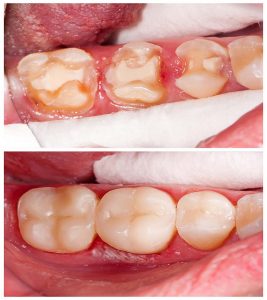Dental filling restore damaged teeth due to tooth decay and to prevent even further damage. To determine the best type of filling to be used, several factors must be considered, this includes the extent of repair needed and the location of the damaged tooth.
Composite filling or White filling
This type of filling is ideal for teeth that are visible when a patient smiles because the resin material matches the color of the natural teeth. However this may not be ideal for teeth that require large fillings as they may chip or wear in the long run. Composite filling are also not as resistant as other materials from coffee, tea, or tobacco stains.
Amalgam (silver) filling
This type of filling is highly resistant to wear and relatively inexpensive alternative. However, due to its unattractive dark color it is often used only for back tooth.
Porcelain filling
This type of filling is also referred to as inlay or onlay as it generally covers most part of the tooth. Porcelain filling is fabricated in a dental lab and bonded to the tooth. Like crown or veneer, it can be made to match the color of the tooth and is stain resistant. Unlike amalgam and composite, porcelain filling requires several visit to the clinic.
Gold filling
This type of filling is made to order. Gold is ideal to highly sensitive gums at it is well tolerated by gum tissues, and may last more than 20 years. For these reasons, it is considered the best material, but the most expensive. Unlike amalgam and composite, gold filling requires several visit to the clinic.


